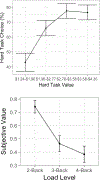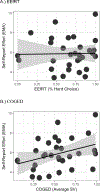Effort in daily life: relationships between experimental tasks and daily experience
- PMID: 33778106
- PMCID: PMC7989786
- DOI: 10.1037/mot0000159
Effort in daily life: relationships between experimental tasks and daily experience
Abstract
Recently, experimental tasks have been developed which index individual differences in willingness to expend effort for reward. However, little is known regarding whether such measures are associated with daily experience of effort. To test this, 31 participants completed an ecological momentary assessment (EMA) protocol, answering surveys regarding the mental and physical demand of their daily activities, and also completed two effort-based decision-making tasks: the Effort Expenditure for Rewards Task (EEfRT) and the Cognitive Effort Discounting (COGED) Task. Individuals who reported engaging in more mentally and physically demanding activities via EMA were also more willing to expend effort in the COGED task. However, EMA variables were not significantly associated with EEfRT decision-making. The results demonstrate the ecological, discriminant, and incremental validity of the COGED task, and provide preliminary evidence that individual differences in daily experience of effort may arise, in part, from differences in trait-level tendencies to weigh the costs versus benefits of actions.
Figures



Similar articles
-
Cognitive Effort-Based Decision-Making Across Experimental and Daily Life Indices in Younger and Older Adults.J Gerontol B Psychol Sci Soc Sci. 2023 Jan 28;78(1):40-50. doi: 10.1093/geronb/gbac167. J Gerontol B Psychol Sci Soc Sci. 2023. PMID: 36242777 Free PMC article.
-
The cognitive effort expenditure for rewards task (C-EEfRT): A novel measure of willingness to expend cognitive effort.Psychol Assess. 2018 Sep;30(9):1237-1248. doi: 10.1037/pas0000563. Epub 2018 Apr 5. Psychol Assess. 2018. PMID: 29620381
-
Effort expenditure for rewards task modified for food: A novel behavioral measure of willingness to work for food.Int J Eat Disord. 2018 Dec 31. doi: 10.1002/eat.22999. Online ahead of print. Int J Eat Disord. 2018. PMID: 30597585
-
Effort, avolition and motivational experience in schizophrenia: Analysis of behavioral and neuroimaging data with relationships to daily motivational experience.Clin Psychol Sci. 2020 May 1;8(3):555-568. doi: 10.1177/2167702620901558. Epub 2020 Apr 22. Clin Psychol Sci. 2020. PMID: 33758684 Free PMC article.
-
Effort-Based Decision Making: A Novel Approach for Assessing Motivation in Schizophrenia.Schizophr Bull. 2015 Sep;41(5):1035-44. doi: 10.1093/schbul/sbv071. Epub 2015 Jun 18. Schizophr Bull. 2015. PMID: 26089350 Free PMC article. Review.
Cited by
-
Associations Between Cognitive and Physical Effort-Based Decision Making in People With Schizophrenia and Healthy Control Subjects.Biol Psychiatry Cogn Neurosci Neuroimaging. 2023 Jul;8(7):695-702. doi: 10.1016/j.bpsc.2023.02.003. Epub 2023 Feb 14. Biol Psychiatry Cogn Neurosci Neuroimaging. 2023. PMID: 36796513 Free PMC article.
-
Impaired Effort Allocation in Patients with Recent-Onset Schizophrenia and Its Relevance to Negative Symptoms Assessments and Persistent Negative Symptoms.J Clin Med. 2022 Aug 28;11(17):5060. doi: 10.3390/jcm11175060. J Clin Med. 2022. PMID: 36078990 Free PMC article.
-
Cognitive Effort-Based Decision-Making Across Experimental and Daily Life Indices in Younger and Older Adults.J Gerontol B Psychol Sci Soc Sci. 2023 Jan 28;78(1):40-50. doi: 10.1093/geronb/gbac167. J Gerontol B Psychol Sci Soc Sci. 2023. PMID: 36242777 Free PMC article.
-
Generalized Encoding of the Relative Subjective Value of Cognitive Effort in the Dorsal ACC.J Neurosci. 2024 Sep 18;44(38):e0367242024. doi: 10.1523/JNEUROSCI.0367-24.2024. J Neurosci. 2024. PMID: 39122557 Free PMC article.
-
Dissociation of Cognitive Effort-Based Decision Making and Its Associations With Symptoms, Cognition, and Everyday Life Function Across Schizophrenia, Bipolar Disorder, and Depression.Biol Psychiatry. 2023 Sep 15;94(6):501-510. doi: 10.1016/j.biopsych.2023.04.007. Epub 2023 Apr 18. Biol Psychiatry. 2023. PMID: 37080416 Free PMC article.
References
-
- Bates D, & Sarkar D (2007). Ime4: Linear mixed-effects models using S4 classes. ‘R’package Version 0.9975–12. URL http://CRAN.R-project.org.
-
- Cacioppo JT, & Petty RE (1982). The need for cognition. Journal of Personality and Social Psychology, 42(1), 116–131. 10.1037/0022-3514.42.1.116 - DOI
Grants and funding
LinkOut - more resources
Full Text Sources
Research Materials
